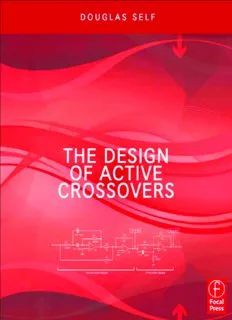Table Of ContentThe Design of
Active Crossovers
This page intentionally left blank
The Design of
Active Crossovers
Douglas Self
AMSTERDAM(cid:129)BOSTON(cid:129)HEIDELBERG(cid:129)LONDON
NEWYORK(cid:129)OXFORD(cid:129)PARIS(cid:129)SANDIEGO
SANFRANCISCO(cid:129)SINGAPORE(cid:129)SYDNEY(cid:129)TOKYO
FocalPressisanImprintofElsevier
FocalPressisanimprintofElsevier
225WymanStreet,Waltham,MA02451,USA
TheBoulevard,LangfordLane,Kidlington,Oxford,OX51GB,UK
©2011DouglasSelf.PublishedbyElsevier,Inc.Allrightsreserved.
Nopartofthispublicationmaybereproducedortransmittedinanyformorbyanymeans,electronicor
mechanical,includingphotocopying,recording,oranyinformationstorageandretrievalsystem,without
permissioninwritingfromthepublisher.Detailsonhowtoseekpermission,furtherinformationaboutthe
Publisher’spermissionspoliciesandourarrangementswithorganizationssuchastheCopyrightClearance
CenterandtheCopyrightLicensingAgency,canbefoundatourwebsite:www.elsevier.com/permissions.
ThisbookandtheindividualcontributionscontainedinitareprotectedundercopyrightbythePublisher(other
thanasmaybenotedherein).
Notices
Knowledgeandbestpracticeinthisfieldareconstantlychanging.Asnewresearchandexperiencebroadenour
understanding,changesinresearchmethods,professionalpractices,ormedicaltreatmentmaybecomenecessary.
Practitionersandresearchersmustalwaysrelyontheirownexperienceandknowledgeinevaluatingandusing
anyinformation,methods,compounds,orexperimentsdescribedherein.Inusingsuchinformationormethods
theyshouldbemindfuloftheirownsafetyandthesafetyofothers,includingpartiesforwhomtheyhavea
professionalresponsibility.
Tothefullestextentofthelaw,neitherthePublishernortheauthors,contributors,oreditors,assumeany
liabilityforanyinjuryand/ordamagetopersonsorpropertyasamatterofproductsliability,negligenceor
otherwise,orfromanyuseoroperationofanymethods,products,instructions,orideascontainedinthe
materialherein.
LibraryofCongressCataloging-in-PublicationData
Self,Douglas.
Thedesignofactivecrossovers/DouglasSelf.
p.cm.
Includesbibliographicalreferences.
ISBN978-0-240-81738-5
1.Electric filters, Active–Designandconstruction. I. Title.
TK7872.F5S4472011
621.3815'324–dc22 2011013096
BritishLibraryCataloguing-in-PublicationData
AcataloguerecordforthisbookisavailablefromtheBritishLibrary.
ForinformationonallFocalPresspublications
visitourwebsiteatwww.elsevierdirect.com
PrintedintheUnitedStatesofAmerica
11 12 13 14 5 4 3 2 1
To Julie with all my love
This page intentionally left blank
Contents
Preface................................................................................................ xix
Acknowledgments.................................................................................. xxiii
Chapter 1: Crossover Basics....................................................................... 1
1.1 What a Crossover Does...........................................................................1
1.2 Why a Crossover Is Necessary..................................................................2
1.3 Beaming and Lobing...............................................................................2
1.4 Active Crossover Applications..................................................................4
1.5 Bi-Amping and Bi-Wiring........................................................................5
1.6 Loudspeaker Cables................................................................................8
1.7 The Advantages and Disadvantages of Active Crossovers.............................8
1.7.1 The Advantages of Active Crossovers...................................................9
1.7.2 The Disadvantages of Active Crossovers.............................................15
1.8 The Next Step in Hi-Fi..........................................................................17
1.9 Active Crossover Systems......................................................................17
1.10 Matching Crossovers and Loudspeakers..................................................22
1.11 A Modest Proposal: Popularising Active Crossovers.................................23
1.12 Multi-Way Connectors.........................................................................24
1.13 Subjectivism.......................................................................................25
References..................................................................................................26
Chapter 2: How Loudspeakers Work.......................................................... 27
2.1 Sealed Box Loudspeakers.......................................................................27
2.2 Reflex (Ported) Loudspeakers.................................................................29
2.3 Auxiliary Bass Radiator (ABR) Loudspeakers...........................................30
2.4 Transmission Line Loudspeakers.............................................................31
2.5 Horn Loudspeakers................................................................................31
2.6 Diffraction............................................................................................32
2.7 Modulation Distortion............................................................................37
Further Reading..........................................................................................37
References..................................................................................................37
vii
Contents
Chapter 3: Crossover Requirements............................................................ 39
3.1 General Crossover Requirements............................................................. 39
3.1.1 Adequate Flatness of Summed Amplitude/Frequency
Response On-Axis...........................................................................39
3.1.2 Sufficiently Steep Rolloff Slopes between the Filter Outputs..................40
3.1.3 Acceptable Polar Response................................................................40
3.1.4 Acceptable Phase Response...............................................................41
3.1.5 Acceptable Group Delay Behaviour....................................................41
3.2 Further Requirements for Active Crossovers............................................. 42
3.2.1 Negligible Extra Noise......................................................................42
3.2.2 Negligible Impairment of System Headroom........................................43
3.2.3 Negligible Extra Distortion................................................................44
3.2.4 Negligible Impairment of Frequency Response.....................................44
3.2.5 Negligible Impairment of Reliability...................................................45
3.3 Linear Phase......................................................................................... 45
3.4 Minimum Phase.................................................................................... 45
3.5 Absolute Phase..................................................................................... 46
3.6 Phase Perception................................................................................... 47
3.7 Target Functions................................................................................... 49
References.................................................................................................. 49
Chapter 4: Crossover Types...................................................................... 51
4.1 All-Pole and Non-All-Pole Crossovers..................................................... 51
4.2 Symmetric and Asymmetric Crossovers.................................................... 52
4.3 All-Pass and Constant-Power Crossovers.................................................. 52
4.4 Constant-Voltage Crossovers................................................................... 53
4.5 First-Order Crossovers........................................................................... 54
4.5.1 First-Order Solen Split Crossover.......................................................60
4.5.2 First-Order Crossovers: 3-Way...........................................................60
4.6 Second-Order Crossovers....................................................................... 62
4.6.1 Second-Order Butterworth Crossover..................................................62
4.6.2 Second-Order Linkwitz–Riley Crossover.............................................69
4.6.3 Second-Order Bessel Crossover..........................................................70
4.6.4 Second-Order 1.0dB-Chebyshev Crossover.........................................73
4.7 Third-Order Crossovers.......................................................................... 75
4.7.1 Third-Order Butterworth Crossover.....................................................76
4.7.2 Third-Order Linkwitz–Riley Crossover................................................79
4.7.3 Third-Order Bessel Crossover............................................................81
4.7.4 Third-Order 1.0dB-Chebyshev Crossover............................................83
4.8 Fourth-Order Crossovers........................................................................ 85
4.8.1 Fourth-Order Butterworth Crossover...................................................86
4.8.2 Fourth-Order Linkwitz–Riley Crossover..............................................88
4.8.3 Fourth-Order Bessel Crossover...........................................................91
4.8.4 Fourth-Order 1.0dB-Chebyshev Crossover..........................................93
viii
Contents
4.8.5 Fourth-Order Linear-Phase Crossover..................................................95
4.8.6 Fourth-Order Gaussian Crossover.......................................................97
4.8.7 Fourth-Order Legendre Crossover.......................................................99
4.9 Higher-Order Crossovers......................................................................102
4.10 Determining Frequency Offsets............................................................102
4.11 Summary of Crossover Properties........................................................104
4.12 Filler-Driver Crossovers......................................................................104
4.13 The Duelund Crossover......................................................................106
4.14 Crossover Topology...........................................................................107
4.15 Crossover Conclusions........................................................................ 112
References................................................................................................112
Chapter 5: Notch Crossovers................................................................... 115
5.1 Elliptical Filter Crossovers....................................................................115
5.2 Neville Thiele MethodTM (NTM) Crossovers...........................................120
References................................................................................................125
Chapter 6: Subtractive Crossovers............................................................ 127
6.1 Subtractive Crossovers.........................................................................127
6.1.1 First-Order Subtractive Crossovers....................................................129
6.1.2 Second-Order Butterworth Subtractive Crossovers...............................130
6.1.3 Third-Order Butterworth Subtractive Crossovers.................................131
6.1.4 Fourth-Order Butterworth Subtractive Crossovers................................132
6.2 Subtractive Crossovers with Time Delays...............................................134
6.3 Performing the Subtraction....................................................................138
References................................................................................................140
Chapter 7: Lowpass & Highpass Filter Characteristics.................................. 141
7.1 Active Filters......................................................................................142
7.2 Lowpass Filters................................................................................... 142
7.3 Highpass Filters...................................................................................142
7.4 Bandpass Filters.................................................................................. 142
7.5 Notch Filters.......................................................................................143
7.6 Allpass Filters.....................................................................................143
7.7 The Order of a Filter............................................................................143
7.8 Filter Cutoff Frequencies and Characteristic Frequencies...........................144
7.9 First-Order Filters................................................................................144
7.10 Second-Order and Higher-Order Filters.................................................145
7.11 Filter Characteristics...........................................................................146
7.11.1 Butterworth Filters........................................................................148
7.11.2 Linkwitz–Riley Filters...................................................................150
7.11.3 Bessel Filters...............................................................................153
7.11.4 Chebyshev Filters.........................................................................153
7.11.5 1dB-Chebyshev Lowpass Filter......................................................158
7.11.6 3dB-Chebyshev Lowpass Filter......................................................158
ix
Description:The Design of Active Crossovers is a unique guide to the design of high-quality circuitry for splitting audio frequencies into separate bands and directing them to different loudspeaker drive units specifically designed for handling their own range of frequencies. Traditionally this has been done by

